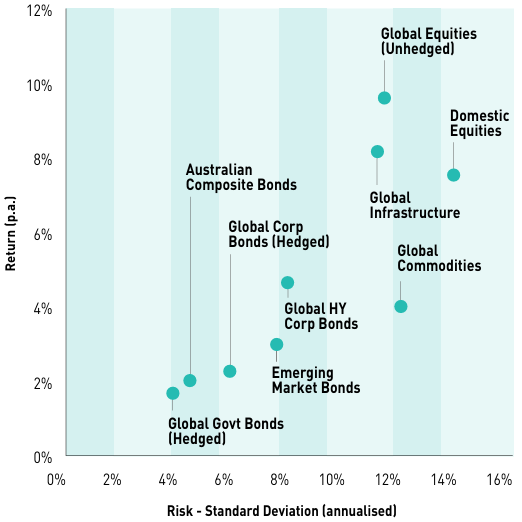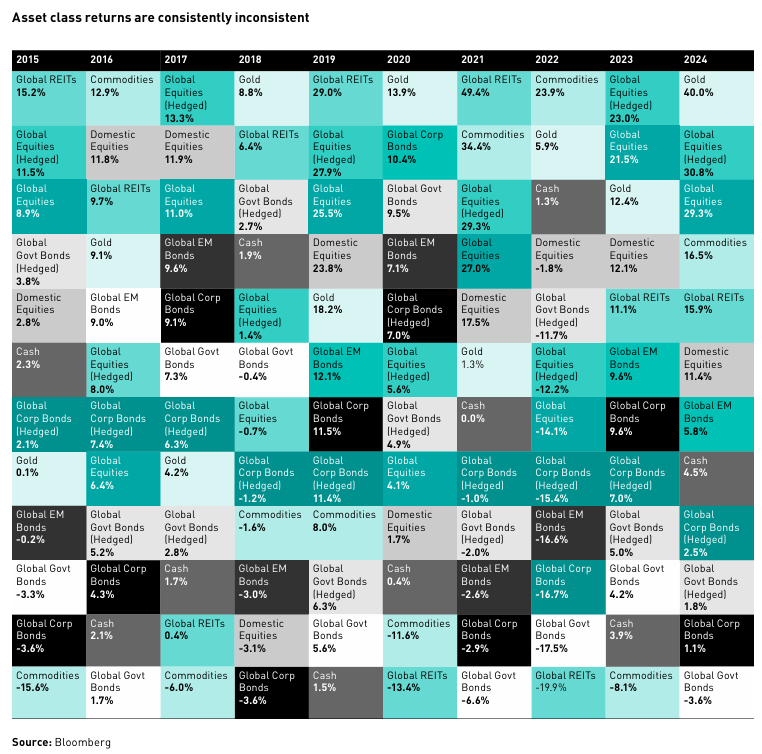The Bell Potter guide to asset allocation: Building wealth that lasts
It’s Saturday morning. You’ve poured your coffee, the markets are quiet, and your mind drifts to that eternal question:
“Am I set up for lasting wealth, or am I just riding the noise of the week that was?”
For most of us, the focus tends to fall on the performance of individual shares; the companies we’ve backed, the ones we regret, and the ones we nearly bought before they became ten-baggers.
But as Bell Potter’s latest Strategic Asset Allocation (SAA) report reminds us, long-term success isn’t defined by individual picks. It comes down to how you allocate across the great pillars of investing: equities, bonds, cash, alternatives - and increasingly, gold.
That last one may raise eyebrows. For decades, gold has been treated in Australia as a tactical hedge, not a core allocation. But Bell Potter, echoing a growing body of U.S. research advocating permanent allocations to bullion, now embeds gold across all investor profiles.
It’s a subtle but significant shift, recognising gold’s liquidity, its role as a crisis diversifier, and its lack of correlation with shares and bonds.
Written by Rob Crookston, Head of Investment Strategy, and Kion Sapountzis, Investment Strategy Analyst, the report is both grounding and forward-looking: a framework to help investors avoid short-term fads and build portfolios that endure.
In this wire, I’ll walk you through the key insights - and how they can help you optimise your portfolio for long-term success.
Why asset allocation matters
The first myth Crookston and Sapountzis set out to dispel in their report is the idea that picking a handful of hot stocks is the key to building lasting wealth.
Stock selection matters, but the overwhelming bulk of wealth creation comes from your SAA settings, exposure to quality assets, and time in the market.
“While active investment decisions can demonstrably lead to significant dispersion in portfolio performance, strategic asset allocation remains a fundamental determinant of a portfolio’s overall direction and forms the fundamental groundwork for an investment strategy,” they wrote.
Academics have long shown this. Brinson, Hood and Beebower (1986) found that asset allocation explained about 90% of the variation in portfolio returns over time. Ibbotson and Kaplan (2000) confirmed it: stock picking may move the needle at the margins, but it’s the mix that sets the course.
Managing risk without hiding from it
Benjamin Graham once said:
“Successful investing is about managing risk, not avoiding it.”
Bell Potter echoes this in its report, encouraging investors to combine asset classes in a way that delivers the return they need for the risk they can live with.
- Equities offer the greatest potential for long-term growth but are also the most volatile.
- Cash provides maximum stability but minimal growth.
- Bonds sit in between, offering modest returns with less volatility than shares.
- Alternatives such as infrastructure, private credit, commodities and gold provide a further layer of diversification.
The chart below shows the historical returns of major asset classes over the past decade. The lesson is simple: you don’t need an all-equities portfolio to grow wealth. Global equities and infrastructure, for instance, delivered slightly higher returns than domestic equities, but with lower risk.

Diversification: the only free lunch
Ever notice how last year’s hero asset often becomes this year’s disappointment? That’s another key message from the report.
The asset class “gameboard” below makes the point clear. Gold topped the table in especially volatile years like 2024, 2020 and 2018. Bulk commodities, on the other hand, swing from feast to famine. And it’s nearly impossible to predict whether Australian or global shares will take the crown in any given year.
With today’s wide menu of exchange-traded funds, investors can access virtually all of these asset classes. The challenge, of course, is how much to allocate to each key asset.
“Allocating to a mix of assets that are not correlated allows investors to build a portfolio that is more resilient across the entire business cycle,” Crookston and Sapountzis wrote.
Diversification won’t make you rich overnight, but it will keep you in the game. And staying in the game is half the battle.

Time in the market beats timing the market
If there’s one lesson investors nod to on Saturday mornings but too often forget by Monday, it’s this: wealth is built by staying invested, not by darting in and out.
Bell Potter runs the numbers across 20 years of the ASX 200, and the conclusion is sobering:
- Stay fully invested → 7.6% annual return
- Miss the 10 best trading days → 4.8% annual return
- Miss the 20 best days → returns collapse even further
“Time in the market generally beats timing the market as many of the best-performing days occur during or soon after a market downturn," the analysts said.
Think back to March 2020. Fear was everywhere. Equities were in free fall. Many investors pulled their money. Yet four of the ten best days of the past two decades occurred during that same selloff and recovery. Those who sat in cash missed the rebound.
The takeaway is both simple (and hard): when your gut tells you to run, your discipline should tell you to hold. Asset allocation provides the foundation that keeps you in the market through the hardest days - and those are often the ones that matter most.
Bell Potter’s framework in practice
Bell Potter boils its framework down to five investor profiles. They’re designed to match different appetites for risk and reward.
- Defensive – 80% in cash and bonds, 2–3 year horizon, ~4.5% p.a. expected return
- Conservative – 60% defensive, 3–4 years, ~5.3% p.a.
- Balanced – 60/40 growth-defensive, 5 years, ~6.1% p.a.
- Growth – 77% growth assets, 6 years, ~6.8% p.a.
- High Growth – 91% growth assets, 7 years, ~7.3% p.a.
“The objective of a strategic asset allocation is to provide a long-term framework that is not reliant on short-term market views. It allows investors to set expectations, reduce behavioural mistakes, and remain invested through cycles,” Crookston and Sapountzis wrote.
Every roadmap has been tested against the market calamities including the GFC, the Euro debt crisis, COVID - plus 50,000 simulations. None of them promise smooth sailing, but all are designed to get you to the other side without severe bruising.
Gold takes a permanent seat
The standout change in this year’s framework is the deliberate inclusion of gold across all profiles:
- 5% in High Growth
- 4% in Growth
- 3% in Balanced
- 2% in Conservative and Defensive
This may sound modest, but it’s a meaningful shift.
Traditionally, Australian allocation models ignored gold. In contrast, U.S. endowment studies and investment banks now recommend 10–20% allocations for its liquidity, crisis-hedge qualities, and ability to preserve purchasing power. Bell Potter hasn’t gone that far, but the direction is clear: gold is a strategic portfolio pillar.
Their framework filters down as follows for portfolios using listed products including stocks, listed investment companies and ETFs:

Other levers in the mix
The framework also makes room for alternatives including private credit, infrastructure, and commodities. These assets provide diversification but require longer holding periods.
"For the appropriate investor, a greater allocation can smooth out portfolio volatility and enhance returns, though this requires a comfort with tying up capital for longer periods," Crookston and Sapountzis wrote.
Additionally, Bell Potter distinguishes between strategic and tactical allocation. The SAA is the anchor. Tactical tilts are the overlay - useful in the short term, but never a substitute for the long-term blueprint.
Final tips from the report
Crookston and Sapountzis close their report with a set of timeless reminders for investors:
- Rebalance regularly – don’t let winners run and distort your portfolio.
- Respect the long game – SAA is the anchor; tactical tilts and active bets are designed to generate a bit of alpha.
- Stay disciplined – the best days often arrive in the worst markets, and only those still invested capture them.
Finally - and most importantly - once you’ve nailed your asset mix and stuck with quality, the hard part is already done. The rest is just waiting.
"Periods of market downturns are often offset with gains as markets rebound, with longer term investors able to reap the rewards of compounding over time," they said.
3 topics

